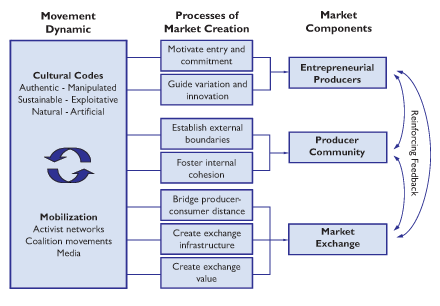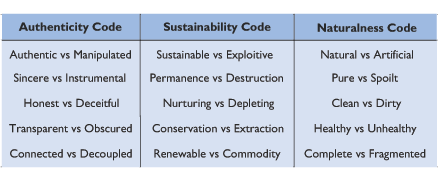Featured Faculty
Thomas G. Ayers Chair in Energy Resource Management; Professor of Management and Organizations
There is an assumption that companies start producing environmentally friendly or “green” products when consumers demand them. As gas prices soar, truck and sport utility vehicle plants close down, and fuel-efficient vehicles become the rage in today’s markets, the reality of this truth is hard to dispute. However, new research from Kellogg School of Management Professor Klaus Weber and his colleagues suggests that demand is not the only “mother of invention.” Sometimes people are guided by strong beliefs about what is right and what is wrong, and, in due course, they can be agents of social and economic change. The researchers demonstrate that in the case of grass-fed meat and dairy products, what first arose was a morally motivated desire among farmers to find a better way to produce food. As a result of their belief that existing farming practices were seriously flawed, pioneers of the movement began to develop radically different techniques. Initially consumers ignored their products, but over time, these pioneers formed a movement-like community and connected with consumers to create a new market.
“It’s a different way of thinking,” Weber explains. “The supply of truly alternative products comes first, and market demand discovers them after the fact.”
New Market Challenges
There are three main challenges to creating a new market: there must be people who are willing and able to produce something new; these entrepreneurs need to form some kind of community; and producers have to find consumers who want the product (see Figure 1). According to a study that Weber and his co-authors, Kellogg graduate student Kathryn Heinze and Northwestern University sociology graduate student Michaela DeSoucey, published in the September 2008 issue of Administrative Science Quarterly, the early activists in the grass-fed products movement successfully used “cultural codes”—basic ways of understanding the world—to help overcome the challenges of creating a new market.
Figure 1: Market Creation in the Grass-fed Products Movement
Beyond Taste: Expanding Assessments of Product Value
The cultural codes helped distinguish “good” versus “evil” approaches to farming, distribution, and food consumption, which allowed those participating in these activities to associate particular practices with affirmations or violations of moral values. These codes were built around three basic oppositions that shaped the thoughts, feelings, and moral understandings of both producers and consumers: authenticity versus manipulation, sustainability versus exploitation of resources, and natural versus artificial processes (see Table 1). According to the paper, the “authenticity” code aligns production, distribution, and consumption of grass-fed products with values such as being sincere and connected to the self, nature, and others. Similarly, the “naturalness” code aligns grass-fed products with a “romanticist notion of nature as inherently pure, complete, clean, and friendly.” The “sustainability” code connects the goals and practices of the movement to a holistic economic, social, and ecological system that is stable and self-sufficient.
Table 1: Oppositions Differentiating Grass-fed and Conventional Production
According to Weber, these cultural codes provided solutions to all three challenges in creating a new market. “Seeing the world as separated into moral oppositions motivated entrepreneurs who wanted to produce, for example, in a more sustainable fashion, and guided the specific kinds of innovations that they explored,” he said. In turn, this world view helped producers to define who they were, who they were not, and what held them together as they forged a community. Finally, the cultural codes helped to connect producers with consumers, forming a shared understanding of the value of the new products. For example, before the grass-fed products movement, assessments of the market value of meat and dairy products concentrated on the quality aspects of the products, such as taste and tenderness. Incorporating moral principles as represented by the three cultural codes allowed entrepreneurial farmers to bring a new dimension to assessments of product value: consumers began to consider production methods as part of what they were paying for. The food they purchased became an affirmation of their own morality, and they were willing to pay a premium for it.
The Snowball Effect
Positive feedback effects between producers and consumers further motivated entrepreneurial activity and helped accumulate knowledge that fueled additional innovation. The researchers described how the emergence of a collective identity gave rise to associations and community groups that allowed producers in different parts of the country to interact more frequently. These meetings and interactions helped increase the knowledge base, which hastened further innovation and lowered the motivational and knowledge thresholds required for additional producers to enter the market. The new market’s success reinforced efforts among producers both through the emotional gratification produced by positive interactions with customers and through the prospects of more certain financial returns.
Weber and his colleagues used an extensive set of data, including interviews, on-site observations, movement publications, Web sites, online discussion forums, news articles, and regulatory filings, to create a detailed case study. They were able to access the experiences and reasoning of participants in great detail, including both pioneering and later-entering producers and consumers. They combined information about the motivation and experiences of individual participants with data about the wider context of this market to validate their findings.
Linking producers with consumers was a key challenge in creating a market for grass-fed products. Although there are exceptions, Weber notes, “The general trend is definitely that the consumers who tend to buy it [grass-fed products] are in more affluent, liberal-leaning urban settings, and the producers are more traditional family farmers in conservative rural areas. Their value systems and social circles are in many regards different, but they converge upon those three cultural codes.” Weber and his colleagues found that the deployment of these codes helped bridge the gap between demographically and culturally different groups by identifying common ground where their moral values overlap. This lesson has profound implications for wider markets.
“Although we identified these codes of authenticity, naturalness, and sustainability within the context of grass-fed products, I think they are very broadly generalizable to alternative and ‘green’ products, and other ideas out there right now that go well beyond agriculture,” Weber asserts. He underscores the important insights that the data provide with respect to how radical innovations that defy conventional industry wisdom come about: “They are not so much driven by financial opportunities or by careful market research, as by fundamentally different ways of thinking about opportunities and an emotional urge to pursue them.”
Ultimately, the research provides an affirmation of all that is good in business and offers a resounding blow to cynicism. Capitalist forces do not have to favor only the cheapest, those who engage in Darwinian games of survival of the fittest, or those who sell their soul to the proverbial devil. The experience of grain-fed dairy and meat farmers revealed that reformers everywhere can take the high road and achieve success.
Weber, Klaus, Kathryn Heinze and Michaela DeSoucey. 2008. “Forage for Thought: Mobilizing Codes in the Movement for Grass-fed Meat and Dairy Products.” Administrative Sciences Quarterly. 53(3): 529-567.